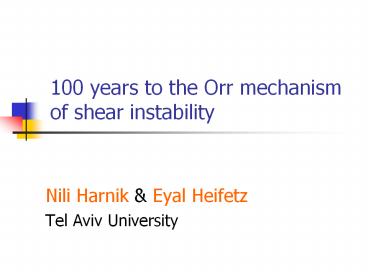100 years to the Orr mechanism of shear instability - PowerPoint PPT Presentation
Title:
100 years to the Orr mechanism of shear instability
Description:
mean vorticity gradient should change sign. 2) The Fjortoft condition (1953) ... but why the mean vorticity gradient does not play any direct role in. energy growth ? ... – PowerPoint PPT presentation
Number of Views:48
Avg rating:3.0/5.0
Title: 100 years to the Orr mechanism of shear instability
1
100 years to the Orr mechanism of shear
instability
- Nili Harnik Eyal Heifetz
- Tel Aviv University
2
(No Transcript)
3
The Orr mechanism (Kelvin, 1887)
4
Revisiting the Orr mechanism (O-M)
- O-M is non-modal, applied to normal modes ?
- O-M conducted originally for shear flow with
zero mean vorticity gradient, relevant to non
zero gradients? - How O-M is related to the necessary conditions
for instability? - 1) Rayleigh inflection point (1880) -
- mean vorticity gradient should change
sign - 2) The Fjortoft condition (1953)
- Positive correlation between the mean
wind and the - mean vorticity gradient
5
Inviscid 2D barotropic shear flow
6
Energy growth via Reynolds stress
7
Enstrophy growth and wave action
The linearized vorticity eq
The wave action
(Eliassen-Palm flux divergence)
8
For energy growth constant shear is enough For
enstrophy growth the vorticity gradient should
change sign
9
well mathematically
0
without shear (U const)
no energy growth
but why the mean vorticity gradient does not
play any direct role in energy growth ?
10
Essence of action at a distance
- Basic PV action at a distance positive PV -
cyclonic flow
- If we have a background PV gradient
- Creation of new PV anomalies by advection
qygt0
q
-q
- Waves can be maintained
C
11
The generation of Rossby waves
If you flip the direction of PV gradient, the
wave phase speed changes as well
qylt0
-q
q
q
- Waves can be maintained
qylt0
C
q
12
Inviscid 2D barotropic shear flow
13
(No Transcript)
14
(No Transcript)
15
(No Transcript)
16
(No Transcript)
17
(No Transcript)
18
(No Transcript)
19
(No Transcript)
20
The Kernel Rossby Wave approach
21
Divide the PV field into infinitesimal kernels
Each has an associated velocity field
The velocity is the sum over contributions from
all kernels
3
2
Look at how the kernel amplitude and phase
positions change with time
1
22
And the math looks something like this
Each KRW induces a meridional wind everywhere a
Green Function approach The total velocity field
is therefore
From the PV equation, obtain the KRW evolution
equations for the amplitude and phase of the PV
kernels
Growth
Propagation
the basic evolution dynamics is the same as the
2-CRWs
23
KRW practical representation
24
Energy versus Enstrophy growth the Orr
mechanism
time
25
The Orr mechanism CRW description
-
-
C.R.W
-
C.R.W
Later
26
The Orr mechanism KRW description
For the 2 CRW paradigm (Heifetz Methven 2005)
vorticity growth
generalized Orr
27
The Orr mechanism CRW description
vorticity growth
generalized Orr
classic Orr (shear)
counter prop
CRW inter
The shear is the only source for instantaneous
energy growth !!! (whether or not a mean PV
gradient exists)
28
The Orr mechanism KRW description
For a continuous set of KRWs
which is equivalent to the common expression
Reynolds stress
Orr is a non-modal (transient) mechanism, but
acts as the only energy source in NMs as
well.
29
(No Transcript)
30
The Orr mechanism in normal modes
- Could be interpreted in 2 equivalent forms
- All KRWs are phase-locked, i.e. the shear never
succeeds to form relative KRW motion. - Energy growth is proportional to the shear,
however resulted from the KRW amplitude growth
due to mean PV advection. - b) The Orr mechanism operates but continuously
re-stoked - by the KRW interaction Lindzen view
31
The Orr mechanism and optimal non- normal
transient growth
If the matrix A is non-normal (AA AA) Growth
can be found even if all eigenvalues are
negative
Rapid transient growth can be much larger
than the largest exopnential eigenvalue
T
T
32
Non-normal growth (Farrell, 1982)
eigenvectors are orthogonal
However
is obtained
33
(No Transcript)
34
Singular Value Decomposition (SVD)
- Shear flows are generally highly non-normal
systems - Can we identify for a given target time t
- a) what is the initial optimal perturbation?
- b) by how much it will grow ?
- c) what would be its final structure ?
35
The SVD recipe
Lets seek for a matrix M 2 sets of vectors u
and v one set of scalars which satisfy
Since both and Hermitian
both and are orthonormal sets and are
real
(where if M is normal then U V)
36
The SVD recipe (cont)
- the eigenvalues of both and
- the (single) singular values of M
- the two set of singular vectors of M
unitarian matrices
Taking real and positive, so that
- SVD
37
SVD and optimal growth
38
Generalized Stability Theory (Farrell)
39
(No Transcript)
40
(No Transcript)
41
(No Transcript)
42
(No Transcript)
43
(No Transcript)
44
45
Larger growth in energy than in enstrophy
46
Larger growth in enstrophy than in energy
47
Conclusions
- Orrs outstanding insight on the fundamental
mechanism of shear instability is still valid ! - (with some minor modifications)
48
Whats next ?
Establishing a CRW-KRW analogous description to
gravity wave type.
49
Thank you !

